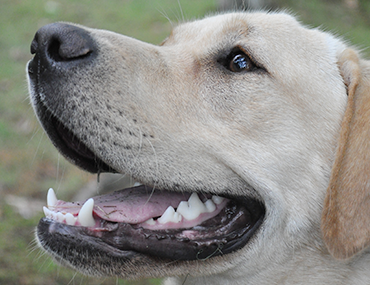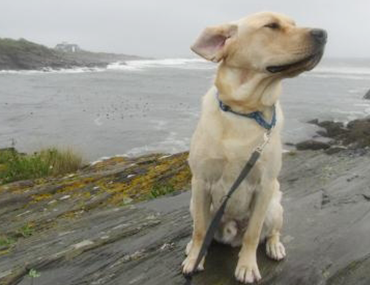Chris Longenecker, a Certified Veterinary Technician in Reading, PA, contributed to this article.
Laryngeal paralysis is a condition that severely affects a pet’s breathing. In the veterinary world, we tend to call it “Lar Par."
The larynx is the medical name for the voice box. Please note, it is larynx and not “lar-nynx” as many people call it. If you've ever had a sore throat or laryngitis, then your very own larynx was irritated. The larynx’s job is to close off after we inhale, open up when we inhale, and again shut off when we eat and drink so we don't “swallow the wrong way.” But in pets (especially dogs), when laryngeal paralysis occurs, none of these things happen. Taking a deep breath becomes impossible, and the pet basically suffocates.
Who is affected by Laryngeal Paralysis?
The typical patient is an older, large breed dog. The poster child is the Labrador, and other common breeds include Golden Retrievers and Setters.
What are the signs of Laryngeal Paralysis?
Lar Par is a very stressful condition to the patient – who obviously doesn’t understand what is going on. The dog literally suffocates. Typically, the signs are progressive. The dog pants without exercising, has noisy and labored breathing, and gets tired quickly during regular walks. Guardians may notice that their dog’s voice changes and sounds hoarse.

Unfortunately, because Lar Par most often occurs in older dogs, the signs are often mistaken for old age and arthritis, which delays treatment. Therefore, Lar Par patients are often presented to a vet when they are in real trouble, usually when they can barely breathe. This commonly happens as the weather becomes hot and humid, and obesity can exacerbate the condition. At worst, Lar Par can become life-threatening.
What causes Laryngeal Paralysis?
Most of the time, we don't know. This is called “idiopathic” Lar Par. Lar Par occurs because the nerves that control the muscles which act on the cartilage of the larynx are diseased. Typically, the condition starts on one side (“unilateral” paralysis or hemiparesis). Only when the condition affects both sides of the larynx (“bilateral” paralysis) will most pet owners realize that there is a problem.
How does a vet know my dog has Laryngeal Paralysis?
An experienced vet or surgeon will suspect Lar Par the second they walk into the exam room. To confirm the suspicion, an exam of the larynx under sedation is necessary. Under sedation, the mouth is opened and the larynx is observed. With Lar Par, the folds of the larynx will not open and close as the patient breathes in and out. The folds remain closed – paralyzed. Before this can be done safely, we perform full blood work and chest X-rays.
What is the emergency treatment?
When a patient presents on an emergency basis, it's crucial to calm the patient and provide them with an ample supply of oxygen. This is usually done by placing the dog in an “oxygen cage.”
If the patient’s temperature is really high from overheating, emergency measures are taken to lower it. Once the patient is stable, surgery is the best treatment.
What happens in surgery, what is the prognosis, and are there any complications?
The goal of surgery is to permanently open up the larynx to allow more air to get in. These days, most surgeons will do a “tie-back” procedure. Typically, surgery involves placing two heavy nylon sutures (i.e. permanent) to open up the left side of the larynx. Only one side is opened up to minimize the risk of aspiration pneumonia.
In experienced hands, the outcome is typically good. Theoretically, surgery provides instant relief: with an open larynx, the patient can finally breathe. Then, of course, the pet needs to recover and heal after surgery.
Clients routinely worry about doing this surgery in their older dog. My standard replies are:
- Age is not a disease.
- Lar Par is not a death sentence. It’s a bump along the road, which shouldn’t significantly affect the patient’s life expectancy as long as they don’t get aspiration pneumonia.
Coughing is expected after surgery, typically after eating and mostly after drinking. That’s a good thing, as it will hopefully prevent the dog from “swallowing the wrong way.” The voice will change, and barking disappears. However, failure of the sutures and a disease in the cartilage of the larynx is a rare but severe complication, which is why we insist on confinement, peace, and quiet after surgery. Another serious complication is aspiration pneumonia (also known as AP). This is a type of pneumonia due to aspiration, or inhalation, of food, water, saliva or vomit into the lungs. Thankfully it, like suture failure, is an uncommon complication.
 What if my pet gets aspiration pneumonia? Then what?
What if my pet gets aspiration pneumonia? Then what?
It's crucial that aspiration pneumonia is caught early. We look for 4 criteria: coughing, lethargy, poor appetite and a fever. If you ever suspect AP, time is of the essence. A vet should see the patient ASAP, listen to the lungs and take chest X-rays to confirm the diagnosis. Treatment involves hospitalization, IV fluids, strong antibiotics, nebulization and a type of physical therapy called coupage.
What’s new with Laryngeal Paralysis?
We now give patients an anti-vomiting drug (metoclopramide), for life, after surgery. The hope is to decrease the risk of vomiting by helping move food downward. It is cheap with very few side effects, though one effect is hyperactivity. Ironically, Labs are the number one breed affected by Lar Par, and many of them are rather hyper to begin with! So far, we have not heard many complaints about using metoclopramide, though contra-indication is patients with seizures, so another anti-vomiting drug should be used. It is important to note that not all surgeons will prescribe this drug, so please don’t be surprised if it is not suggested. It is certainly not mandatory.
These days, we don’t make the opening in the larynx as big as we used to, just enough for the patient to breathe comfortably. This is clearly art more than science, and you can see how experience comes into play. What’s the downside? The patient will likely have a noisier breathing, as air goes through a smaller opening. But again, as long as the patient can breathe comfortably, we don’t mind. As I now tell my clients, “I don’t treat noise, I treat dogs.”
What do I need to do at home after surgery?
This will depends on your surgeon’s recommendations. In our practice, we recommend:
- Strict rest for two months to allow healing with scar tissue
- Soft food (“meat balls”) for two weeks
- Not too much water intake at once
- Pain killers for seven days
- Metoclopramide for life (again, not all surgeons do that)
- Weight loss (these patients are often chubby), or weight control as needed
- Long term, we recommend using a harness instead of a neck collar
The only restriction is swimming: your dog will have a permanently open larynx, with no possibility of closing it off, should (s)he swallow water. There is therefore a risk of aspiration at best, and drowning at worst.
Overall, Lar Par is a stressful condition for the dog and a stressful situation for the guardian. Fortunately, in most cases, results of Laryngeal Paralysis surgery are good to excellent.
If you have any questions or concerns, you should always visit or call your veterinarian – they are your best resource to ensure the health and well-being of your pets.
